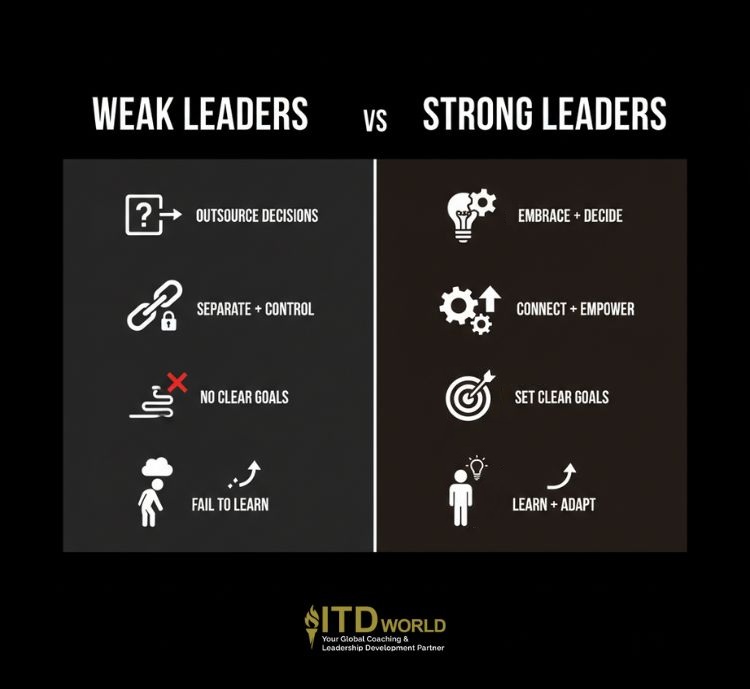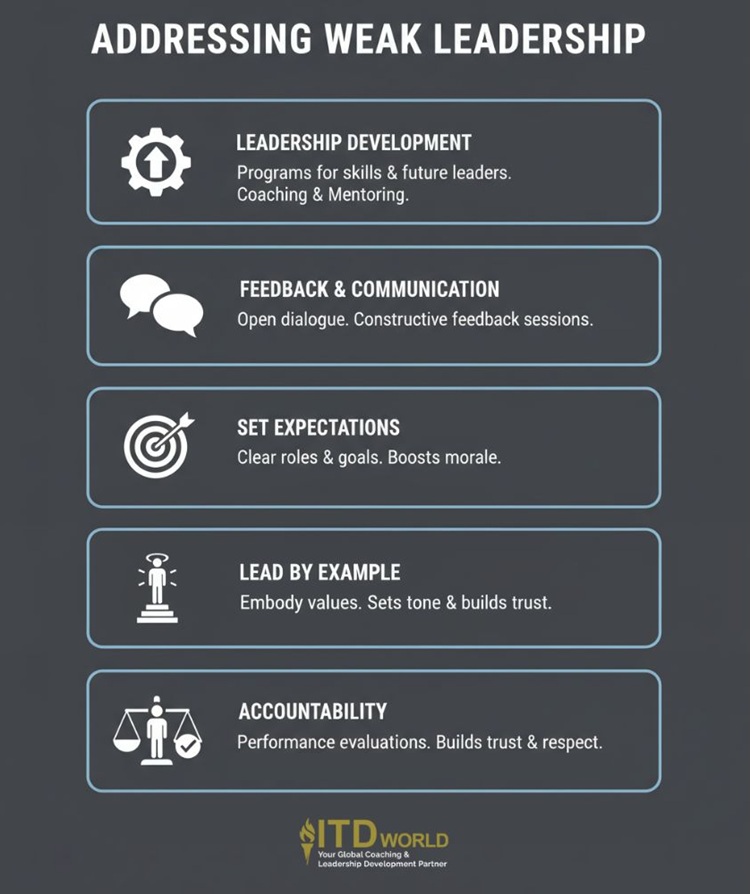Explore the detrimental impact of weak leadership, plus best practices to avoid being bad leaders and ensure organizational success.
A vital success factor for organizations is strong leadership. Effective leaders move their teams for results by driving collaboration, inspiring innovation, and motivating personal growth. On the other hand, the opposite of strong leadership is weak leadership. Bad leaders pose an extremely detrimental impact on an organization’s long-term success.
|
Author: Aaron Ngui |
Highlights
- Weak leaders are those who fail to demonstrate essential leadership qualities and instead exhibit negative traits that harm their team, organization, or performance.
- Bad leadership often manifests in a lack of clear vision, poor communication, indecisiveness, and a failure to lead by example, leading to negative outcomes for the team and organization.
- Unlike strong leaders who typically embrace collaboration, empower their team, and provide constructive guidance, weak ones tend to avoid confrontation, micromanage, and provide ineffective feedback.
- Poor attitude, lack of self-awareness, bad communication skills, overreliance on knowledge, and inadequate support from the organization are among the factors that cause weakness in leadership – which then leads to decreased morale, reduced productivity, negative impact on innovation, damaged reputation, and financial implications for the organization.
- Addressing the problem involves investing in leadership development, encouraging open communication, setting clear expectations, leading by example, and holding executives accountable.
What is Weak Leadership?
Weak leadership (also known as bad/ poor leadership/ toxic/ negative leadership) is a term that describes leaders who either:
- Fails to demonstrate typical leadership qualities – such as vision, integrity, decisiveness, communication, feedback, motivation, or accountability.
- Exhibit traits/ behaviors that negatively affect their team, organization, or performance.
Example:
A company’s marketing team is led by a manager who lacks decisiveness and communication skills. This manager struggles to articulate clear goals and expectations for the team, resulting in confusion and uncertainty among team members. Additionally, he tends to avoid making tough decisions, often deferring to others or seeking consensus even when timely decisions are critical.
It is worth noting that the term does not necessarily mean a complete lack of leadership. Rather, it implies an inability to provide effective guidance and support to the team. Addressing this shortcoming is crucial for leaders to foster a positive and productive work environment, ultimately contributing to the success of the team and the organization as a whole.

Poor leadership in business
How Does Weak Leadership Show Up?
Weak leadership manifests in various ways. These can include a lack of clear vision, poor communication, indecisiveness, and a failure to lead by example.
All in all, here is a list of common bad leadership characteristics:
- Distance and hierarchy: Weak leaders often separate themselves from their team; as a result, they create a sense of distance and hierarchy within the team – which results in a lack of connection between them and other members and a diminished sense of unity within the organization.
- Overly critical behavior: Poor leaders often exhibit overly critical behavior – they pay too much attention to team members’ faults and mistakes, rather than recognizing their strengths and achievements. Their critical stance contributes to a negative work environment and hinders the development of a positive and supportive team culture.
- Micromanagement: Micromanagement is another common trait of weak leaders. They interfere with their employees’ autonomy and creativity instead of empowering them to make decisions, take ownership of their tasks, and grow professionally. Their so-called leadership style breeds a culture of fear and disengagement, stifling innovation and initiative.
- Lack of trust and confidence: Bad leaders may require constant contact and updates from their team due to their lack of trust in others’ abilities. As a result, employees are likely to feel their capabilities are not valued.
- Lack of integrity and ethical conduct: Acting without integrity, breaking promises, lying, or behaving unethically are hallmarks of weak leadership. Such behaviors erode trust within the team and bring about severe consequences for the organization’s reputation and ethical standing.
- Failure to set clear expectations: Weak leaders fail to set clear expectations, goals, and objectives for their team. This lack of clarity leaves people directionless and causes a lack of motivation among team members, as they struggle to understand their role in visualizing organizational goals.
- Ineffective communication: Ineffective leaders may withhold information, make decisions without consulting their team, or provide inadequate feedback. Their failure to communicate clearly and consistently leads to confusion, frustration, and a lack of trust among team members.
- Ineffective feedback: Providing ineffective feedback is another characteristic of weak leaders. They may give too little, too much, or no feedback at all, or their input may be vague, inconsistent, or harsh. In the best-case scenarios, they may just say “Thank you” to people – without giving any further information at all.
- Lack of accountability: Weak leaders typically avoid taking responsibility for their actions – instead, many of them blame others for failures, denying mistakes, or making excuses. Their lack of accountability creates a culture of finger-pointing and hinders the team’s ability to learn and grow collectively.
- Inability to resolve conflict: Despite the importance of conflict management, they often avoid confronting problems, fail to listen to different perspectives, or make biased decisions, leading to unresolved conflicts that negatively impact team dynamics.
- Poor decision-making: Ineffective leaders may make poor decisions due to a lack of information, analysis, or consideration of alternative options. As such, their management results in missed opportunities, increased stress among team members, and a lack of confidence in their direction.
- Inability to adapt to change: Weak leaders resist change and cling to outdated practices. Their fear of the unknown, failure to recognize the need for adaptation, and/or lack of skills to implement change effectively are what hinder organizational growth and competitiveness.
- Lack of emotional intelligence: They may lack empathy, react impulsively to situations, or fail to create a positive and supportive work environment.
- Failure to invest in employee development: Weak leaders view their team members as resources to be exploited rather than individuals to be developed. Their failure to invest in training, mentoring, and personal growth hinders the team’s potential, contributing to high turnover rates and decreased organizational performance.
Weak Leaders vs Strong Leaders
The distinction between weak and strong leaders lies in their traits, behaviors, and the outcomes they generate within an organization.

Decision-making and confrontation:
- Weak leaders: They tend to outsource their decisions, avoiding confrontation and managing by consensus. This approach often leads to indecision and a lack of clarity within the team.
- Strong leaders: They outsource their thinking, embrace uncomfortable conversations, and are not afraid to make independent decisions. Transparency and open acknowledgment of their reliance on others are at the heart of their management philosophy.
Connection with the team:
- Weak leaders: They often separate from their team, displaying critical behavior, micromanaging, and requiring constant contact. This creates a hierarchical and disengaged work environment.
- Strong leaders: Recognizing the importance of collaboration and collective effort, they actively connect with their team, focusing on strengths, empowering individuals, and fostering a culture of trust.
Setting expectations and providing feedback:
- Weak leaders: They fail to set clear expectations, goals, or objectives, leading to confusion and lack of motivation. Additionally, their feedback is often ineffective, hindering the team’s growth and development.
- Strong leaders: They establish clear expectations, goals, and objectives, providing constructive guidance that contributes to individual and team improvement.
Values and decision-making:
- Weak leaders: Lack of a values compass for decision-making potentially leads to inconsistent and ethically questionable choices. They may not be involved in their team’s personal lives and tend to dictate rather than guide.
- Strong leaders: They use values as a guide for decision-making, ensuring alignment with ethical standards. Strong leaders are aware of their team’s personal lives, demonstrate empathy, and focus on teaching individuals how to think rather than dictating what to do.
Learning from setbacks:
- Weak leaders: They often fail to learn from setbacks, resist considering alternative paths, and succumb to negative thoughts. Their mindset impedes growth and hampers resilience in the face of challenges.
- Strong leaders: They learn from failures, explore different possibilities, and actively challenge negative thoughts. They view setbacks as opportunities for improvement and leverage them to adapt and evolve.
| Feature | Weak Leaders | Strong Leaders |
| Decision-making and confrontation | Outsource decisions, avoid confrontation, manage by consensus |
Outsource thinking, embrace uncomfortable conversations, make independent decisions
|
| Connection with the team | Separate from team, critical behavior, micromanaging, require constant contact |
Connect with team, focus on strengths, empower individuals, foster culture of trust
|
| Setting expectations and providing feedback | Fail to set clear expectations, goals, or objectives, ineffective feedback |
Establish clear expectations, goals, and objectives, provide constructive guidance
|
| Values and decision-making | Lack values compass, inconsistent and ethically questionable choices |
Use values as guide for decision-making, ensure alignment with ethical standards
|
| Learning from setbacks | Fail to learn from setbacks, resist alternative paths, succumb to negative thoughts |
Learn from failures, explore different possibilities, challenge negative thoughts
|
Causes of Weak Leadership
Bad leadership stems from a variety of factors, often intertwined with personal traits, organizational dynamics, and external pressures. Here are some common causes of leadership weaknesses:
- Poor attitude: Poor leaders often harbor a negative outlook, potentially stemming from personal dissatisfaction or frustration. Their negative attitude not only affects their own motivation and performance – but also casts a shadow on the team’s morale and productivity.
- Lack of self-awareness and self-development: Ineffective leaders may resist introspection, feedback, and personal growth opportunities. Their lack of self-awareness results in a management style characterized by blind spots, poor decision-making, and an inability to adapt to changing circumstances.
- Poor communication skills: Beyond struggling to convey messages, they often fail to recognize the importance of two-way communication. As such, they might withhold information, neglect feedback channels, and inadvertently foster an environment of mistrust and confusion within the team.
- Overreliance on knowledge: Weak leaders may overly prioritize technical skills and knowledge – while neglecting the interpersonal and emotional dimensions of leadership. This knowledge-centric approach is the main cause of their lack of collaboration, dismissiveness toward others’ perspectives, and a failure to appreciate the broader aspects of effective leadership.
- Busyness to inefficiency: Overwhelmed by their workload, bad leaders may struggle with time management, delegation, and self-care. This excessive busyness jeopardizes their own well-being – as well as contributes to stress, burnout, and compromised decision-making within the team.
- Obliviousness to problems & morale: Bad leaders are often unaware of underlying issues within the team or organization. Their lack of situational awareness results in unresolved conflicts, missed opportunities, and a decline in team morale and cohesion.
- Passing on responsibility: Leaders who shirk accountability may be driven by a fear of failure or a desire to maintain a facade of competence. In doing so, they undermine their own credibility and foster a culture where responsibility is diffused, hindering the team’s ability to learn from mistakes and grow.
- Underestimating the importance of people development: As mentioned, weak leaders may view their team members as mere resources rather than individuals with potential for growth. Their perspective stifles opportunities for training, coaching, mentorship, and personal development, contributing to stagnant team dynamics and diminished organizational performance.
- Lack of support and development for leaders: Organizations that fail to provide adequate support, mentorship programs, leadership training, or constructive feedback mechanisms may inadvertently foster a culture of ineffective leadership.
Read more: Self Leadership – The Art of Leading from Within
Consequences of Weak Leadership in the Workplace
When the leader is weak, various problems will emerge in the organization, including:
Decreased morale
People often become frustrated and disillusioned when they perceive that their leaders are indecisive or disengaged. This results in decreased morale among the teams. Low morale manifests as reduced enthusiasm, increased absenteeism, and a lack of motivation to perform at their best.
For example, if the manager rarely attends team meetings, rarely seeks input, or appears disinterested in team wellbeing, people will feel ignored and undervalued. Once enthusiastic members would begin to show signs of low morale like being late or absent and becoming unmotivated to give their best effort which lowers performance.
Reduced productivity
When leaders are weak, unclear expectations and ineffective management come to the fore. Productivity suffers when team members are unsure about their roles or goals. Additionally, a lack of accountability and poor communication hinders teamwork and collaboration, further impacting overall productivity.
The absence of clear expectations results in projects suffering from a lack of coordination and missed deadlines. Without accountability, the issue worsens. Instead of working together, people would start pointing fingers at each other which strains communication. Productivity ultimately suffers, leading to missed opportunities and a decrease in competitiveness.
Negative impact on innovation
Effective leaders encourage creativity and innovation. They do so by fostering an environment where ideas are welcomed and respected. Bad leaders however may seek to stifle innovation by discouraging risk-taking or failing to provide the necessary resources and support for new initiatives.
Leaders who are risk-averse and prefer maintaining the status quo do not welcome new initiatives. Team members are hesitant to share their innovative ideas as they want to avoid criticism or rejection. This stifled creativity and innovation within the organization. Projects that could have driven the organization for business results are not pursued, leading to missed opportunities and stagnation in a fast-evolving industry.
Damage to reputation
Weak leadership can damage the reputation of an organization. The business is impacted by team members and clients lose trust in the leadership’s ability to deliver on what is promised.
For example, the poor leadership of an executive team eroded trust among the team. Word spread quickly that the leadership was disconnected and indifferent. This internal strife seeped into the company’s interactions with clients.
Customers noticed the decline in employee morale and performance and began to question the company’s ability to deliver. Clients then started to explore alternatives due to the negative perception. This resulted in a loss of business opportunities.
Financial implications
Weak leadership directly impacts a company’s bottom line. Decreased productivity, high turnover, and damaged reputation can result in financial losses and hinder long-term growth.
As an example, poor decisions and weak accountability by the leadership may lead to operational inefficiencies and a high turnover rate. These damage the reputation of the organization – which later causes financial losses. Subsequent dwindling profitability would hamper the organization’s capability to grow and hinder long-term financial stability and development.
The challenge of leadership is to be strong, but not rude; be kind, but not weak; be bold, but not bully; be thoughtful, but not lazy; be humble, but not timid; be proud, but not arrogant; have humor, but without folly.
Jim Rohn

How to Address and Resolve Weak Leadership
Recognizing and addressing weak leadership is crucial for the success of any organization. Here are some steps that can help mitigate the effects of bad leaders:
Leadership development
Invest in leadership development programs to train and develop current and future leaders. These programs allow individuals to acquire the necessary skills and qualities to become effective leaders. An effective leadership skill is coaching and mentoring. Knowing how to coach others lets leaders unleash the potential of others, while effective mentoring plays a crucial role in knowledge and skills transfer.
Feedback and communication
Encourage open and honest communication between leaders and their teams. Constructive feedback can help leaders understand their weaknesses and areas for improvement.
One way to do so is by having regular feedback sessions where employees can share their concerns and ideas. This can lead to constructive dialogues that help leaders identify their gaps. Leaders earn trust and respect when they address their areas of improvement.
Set clear expectations
Leaders should ensure they are setting clear expectations for their teams and provide regular feedback on performance. Clarity in roles and goals can boost morale and productivity. People who know exactly what is expected of them enjoy higher morale and feel a sense of purpose in their work that boosts productivity.
Lead by example
Leaders should exemplify the behavior and values they expect from their team members. Leading by example builds trust and respect within the organization.
A CEO who consistently demonstrates the values and behaviors she expects from team members earns their trust and respect. Her dedication and integrity set the tone for the entire organization of how they should act.
Read more: 10 Leadership Values for Exceptional Results
Accountability
Hold leaders accountable for their actions and decisions. Implement performance evaluations and assessments to ensure that leaders are meeting the organization’s expectations. One approach to promote accountability is to pair people up with accountability partners. Accountability partners keep people on their toes and accountable for the actions and plans that people set out to do.
Read more: Leader vs Boss – 11 Key Differences (Which One Are You?)

Coaching Questions to Overcome Weak Leadership
Addressing weak leadership is a crucial step towards ensuring the growth of any organization. Here are some coaching questions to guide leaders in addressing and mitigating the effects of weak leadership:
- Self-awareness & Leadership development: What specific leadership skills or qualities do you need improvement?
- Feedback & Communication: What steps can you take to encourage open and honest communication?
- Setting clear expectations: How can you ensure clarity of roles, responsibilities, and performance expectations?
- Leading by example: How can leaders align actions and behaviors with the values and expectations of the team?
- Accountability: How to ensure leaders are held accountable for their actions and decisions?
Weak leadership can have far-reaching consequences that impact the success of an organization and the well-being of the team. Recognizing the signs and taking proactive steps to address poor leadership is essential for a positive and productive work environment. Strong leadership is key to unlocking the full potential of any organization and ensuring long-term success.
Be strong, but not rude; Be kind, but not weak; Be bold, but not bully; Be humble, but not timid; Be prooud, but not arrogant.
Zig Ziglar
Weak Leadership Examples & Case Studies
- Marissa Mayer at Yahoo: Marissa Mayer’s tenure as the CEO of Yahoo is often cited as a classic case of bad leadership. Mayer faced criticism for distancing herself from her team, failing to set clear goals, micromanaging, acting without integrity, and disregarding valuable feedback. Her decisions contributed to Yahoo’s decline, ultimately leading to its sale to Verizon in 2017.
- Travis Kalanick at Uber: Travis Kalanick, the co-founder and former CEO of Uber, faced a tumultuous exit in 2017 amid a series of scandals that tarnished the company’s reputation. His leadership was marked by a lack of transparency, accountability, respect, diversity, and ethics. Kalanick’s leadership failures contributed to an unhealthy culture at Uber, affecting both internal dynamics and the company’s external image.
- Jeff Skilling at Enron: The case of Jeff Skilling, former CEO of Enron, is a stark example of weak leadership that led to criminal convictions. Skilling’s leadership was characterized by callousness, corruption, insularity, and indifference. He played a key role in orchestrating fraudulent accounting schemes that ultimately resulted in the collapse of Enron in 2001.
- Nokia’s downfall: Nokia, once a dominant force in the mobile phone industry, faced a significant downfall attributed to poor leadership and strategic decisions. CEO Stephen Elop’s focus on cost-cutting and reluctance to invest in new technologies contributed to the organization’s inability to adapt to the smartphone revolution. The lack of innovation, slow response to market changes, and a decline in the quality of Nokia’s phones further eroded its market share. The board of directors also played a role by failing to recognize the threat of smartphones and making poor strategic decisions.
Read more: Ego in the Workplace – The Hidden ‘Evil’ Behind Team Dysfunctions

Weak Leadership Quotes
Nothing will kill a great employee faster than watching you tolerate a bad one.
Perry Belcher
People don’t leave bad jobs; they leave bad bosses.
Jeff Burkhart
Failing organizations are usually over-managed and under-led.
Stephen Covey
A strong leader accepts blame and gives the credit. A weak leader gives blame and accepts the credit.
John Wooden
Weak leaders cannot tolerate weak leaders above them.
Tom Krause
During critical periods, a leader is not allowed to feel sorry for himself, to be down, to be angry, or to be weak. Leaders must beat back these emotions.
Mike Krzyzewski
True leaders do not make choices with reference to the opinion of the majority. They make choices based on the opinion of the truth, and the truth can come from either the majority or the minority!
Israelmore Ayivor
Check out more quotes on bad leadership here!
Bad Leadership Books
- Bad Leadership: What It Is, How It Happens, Why It Matters by Barbara Kellerman: Kellerman’s book delves into the pervasive nature of weak leadership, challenging the notion that it is an isolated phenomenon. The author identifies seven primary types of bad leadership and meticulously analyzes the factors that lead leaders to transition from good to bad. Kellerman also emphasizes the crucial role of followers, shedding light on how they can either collaborate with or contribute to poor leadership. The inclusion of contemporary examples, ranging from business figures like Mary Meeker to controversial figures like David Koresh, enriches the analysis, making it relevant and relatable.
- Leadership Wise: Why Business Books Suck, but Wise Leaders Succeed by John W. Foreman: Foreman’s publication challenges the conventional advice found in many business books and introduces a practical perspective on business leadership. The author argues that context is paramount, advocating for the use of wisdom literature to guide leaders in their decision-making. Wisdom literature, drawing from sources such as proverbs, fables, and koans, presents paradoxical statements that stimulate critical and creative thinking. Foreman demonstrates how these unconventional sources can help leaders navigate the complexities and uncertainties of their roles.
Read more: Leading Through Uncertainty – How to Navigate Turbulent Times
Enhancing Leadership Capabilities with ITD World’s Training Solutions
In the dynamic and competitive landscape of today’s business world, effective leadership is a linchpin for success. Recognizing the need for continuous learning and skill development, we at ITD World have developed various tailored solutions to empower both individuals and organizations to reach their full potential.
Why choose us:
- Holistic development: ITD’s training programs take a holistic approach to leadership development, addressing diverse facets such as personal growth, effective communication, strategic thinking, and sound decision-making. This comprehensive perspective ensures that leaders are equipped to navigate the complexities of their roles with versatility and agility.
- Action-oriented learning: Participants not only gain theoretical knowledge but also acquire actionable tools and strategies that can be implemented immediately in their work environments. This action-oriented approach accelerates the translation of learning into tangible results.
- Customized solutions: Our training solutions are tailored to ensure that the content, methods, and outcomes align with the specific needs and goals of each leader or organization, maximizing the relevance and impact of the training.
- Expert facilitation: The success of ITD World’s training programs is rooted in the expertise of our team of trainers. Led by experienced and passionate professionals, the training sessions are enriched with practical insights and real-world examples, creating a dynamic and engaging learning experience. Our experts bring a wealth of knowledge to inspire and guide participants on their leadership journey.
Our key solutions:
- Certified Master of Leadership (CML): The CML program is a flagship offering designed to equip senior to mid-level leaders with essential skills and knowledge. The comprehensive curriculum ensures that participants are well-prepared to excel in their roles, driving organizational success through effective leadership.
- Leadership coaching: ITD World’s executive coaching services provide personalized support for leaders to enhance self-awareness, refine communication skills, and develop effective leadership strategies. This one-on-one coaching approach enables leaders to focus on their unique growth areas and maximize their leadership potential.
- Leadership development workshops: Our workshops cover specific leadership topics such as team management, conflict resolution, and change management. As such, they provide practical insights and actionable strategies for immediate implementation, addressing key challenges faced by leaders in today’s dynamic work environment.
- Leadership assessment: Our 360-degree assessment is designed to identify individual leadership strengths and areas for development. As a result, leaders may receive targeted insights, allowing for the creation of bespoke training plans that address their specific growth needs.
Contact ITD World today for a FREE consultation!
Other resources you might be interested in:
- Ego in Leadership: How to Tame It for the Greater Good
- The Power of Apology: How to Say Sorry as a Leader
- Situational Leadership: A Guide for Effective Strategies
- Inspirational Leadership: Igniting Passion & Purpose in Your Team
- Influential Leadership: Influence to Inspire, Lead, and Succeed

